Ever read, and then re-read a sentence and thought, “Wait… does that actually mean what I think it means?”
If so, you’ve just stumbled into the tricky world of ambiguity.
Ambiguity happens when language can be interpreted in more than one way.
It can be used intentionally in art and literature. But more often than not, it happens unintentionally in professional and academic writing, leaving readers scratching their heads in confusion.
So to help you sharpen your writing, read on for a full breakdown of what ambiguity is, the different types of ambiguity to be aware of, and how to spot (and fix) ambiguity in your own writing.
TL: DR – Ambiguity happens when a word or phrase can be interpreted in different ways. Ambiguity is used as a creative tool in the arts and literature. But in everyday professional and academic writing, ambiguity can cause confusion and weaken your message.
Key Takeaways
- Ambiguity occurs when words, phrases, or sentences can be interpreted in multiple ways, which can confuse readers in professional or academic writing.
- Types of ambiguity include lexical, structural, semantic, and pragmatic, each affecting clarity differently.
- Use tools like Undetectable AI’s Grammar Checker and AI Paraphraser to identify and fix ambiguous sentences, ensuring writing is clear and professional.
- While ambiguity can enhance creative writing, it should be minimized in academic, business, and formal contexts to avoid miscommunication.
The Definition of Ambiguity
So, what does ambiguity mean?
In the most basic terms, ambiguity is best defined as:
- When a word, phrase, or sentence has more than one meaning, making it difficult for readers to understand the intended meaning of the writer.
For example, take the sentence: “I saw the man with the telescope.”
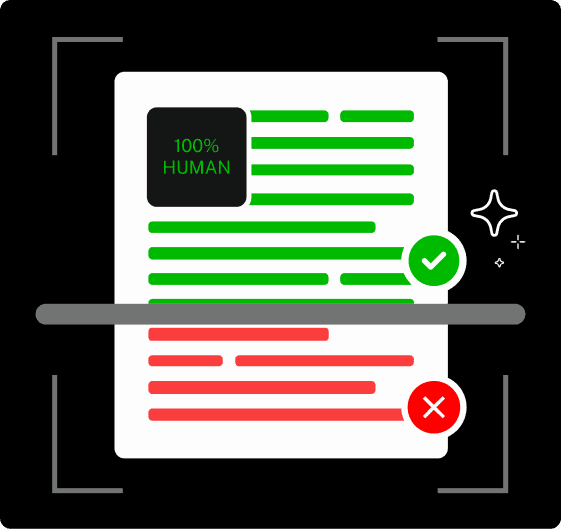
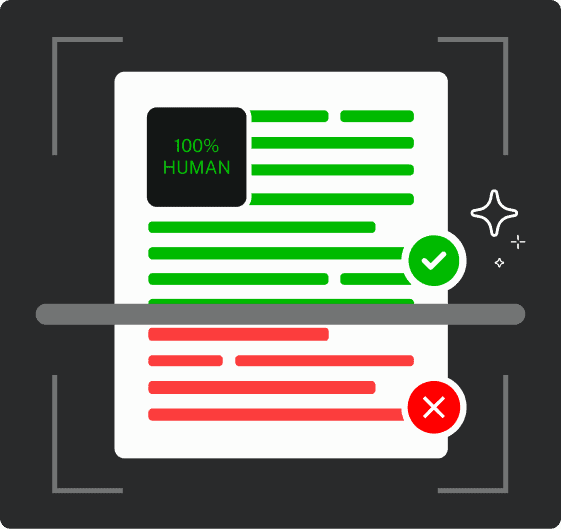
Never Worry About AI Detecting Your Texts Again. Undetectable AI Can Help You:
- Make your AI assisted writing appear human-like.
- Bypass all major AI detection tools with just one click.
- Use AI safely and confidently in school and work.
One person might think that you used the telescope to see the man, while another person might interpret this sentence to mean that the man had the telescope and you saw him with it.
That’s ambiguity, because the sentence can be interpreted in more than one way.
In most forms of writing (like for academic essays or SEO articles), ambiguity is unintentional.
However, in literature and poetry, ambiguity can be used as a deliberate tool to add depth, humor, or irony to a phrase or passage.
Pro Tip for Students and Writers: If you ever get stuck on what words like “ambiguity” mean, use Ask AI to instantly explore the meaning of the word with some examples.
Here’s how:
Step 1: Head to Undetectable AI’s Advanced AI Chat and Chatbot.
Step 2: Type your question into the chat. For example, you could write something like, “What does ambiguity mean in literature?” or “What does moral ambiguity mean?”.
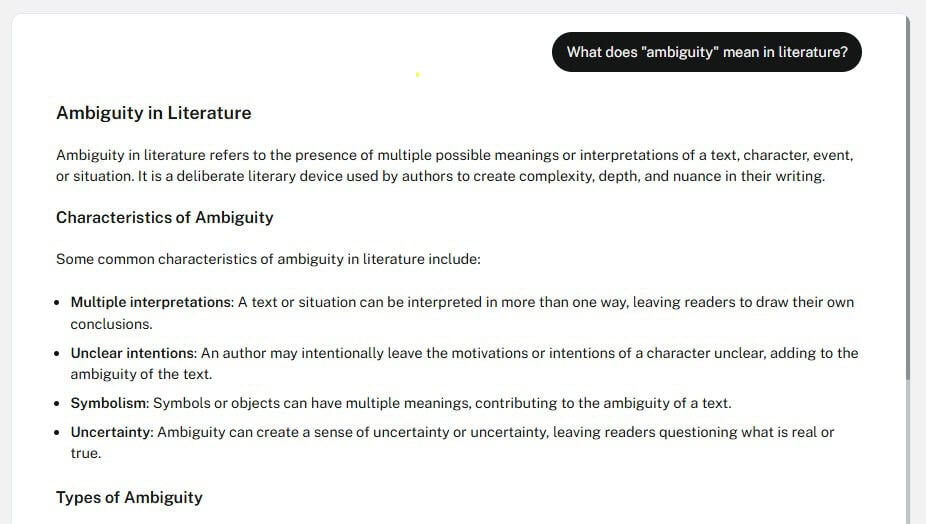
Step 3: Ask the chat to elaborate or provide examples, depending on what you’re interested in learning.
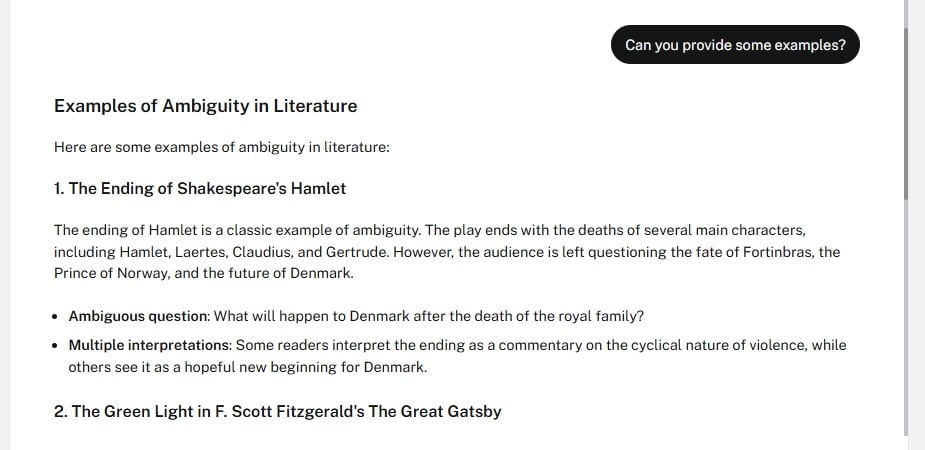
Step 4: Create your own GPT (Click “Create Your GPT” in the left-hand menu bar) and continue to ask questions for even better results.
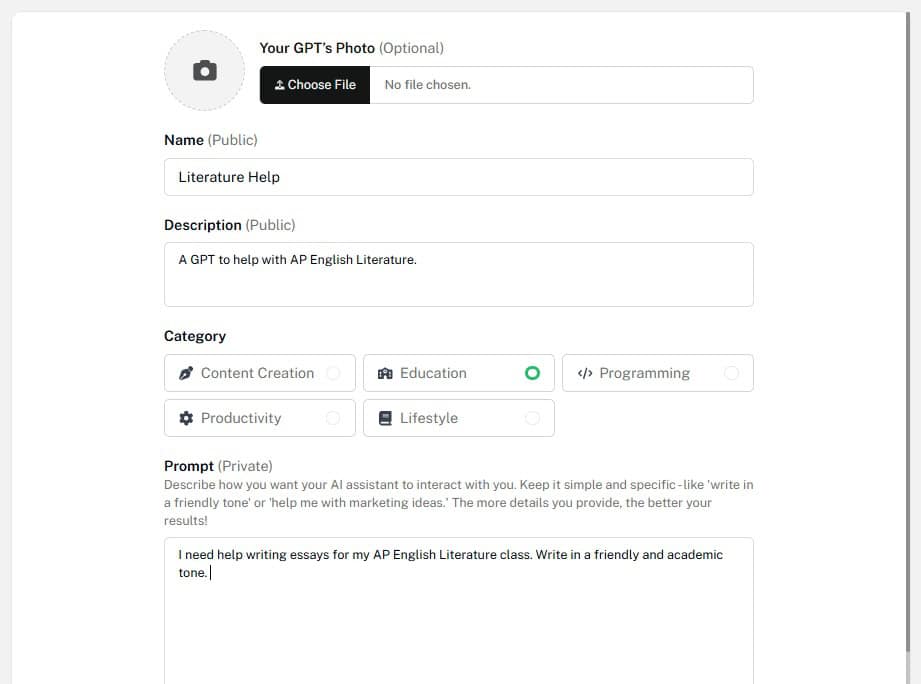
Types of Ambiguity
There are four main types of ambiguity. Here’s a breakdown of each with examples.
Lexical Ambiguity
Lexical ambiguity happens when a single word has more than one possible meaning.
- For example: “The fisherman went to the bank.”
Here, “bank” could mean the edge of a river (which would make sense, given the subject of the sentence is a fisherman).
However, a bank could also mean a financial institution, which also makes sense given the fact that many fishermen sell fish for money.
Without any extra context, it’s nearly impossible to tell what the intended meaning of this sentence is.
This type of ambiguity often appears in everyday conversation because English is packed with ambiguous words that carry multiple meanings.
Structural (or Syntactic) Ambiguity
Structural ambiguity (often called syntactic ambiguity) occurs when the structure of a sentence allows for multiple interpretations.
- For example: “Old men and women sat on the bench.”
Does this sentence mean that both the men and women are old? Or are only the men old?
The uncertainty in this sentence comes from the way that the sentence is arranged.
Structural ambiguity often appears in professional and academic writing (often by accident) when sentence construction is unclear.
Pro Tip for Students and Writers: Use AI Grammar Checker to improve the quality of your writing by detecting and fixing instances of structural ambiguity.
Semantic Ambiguity
Semantic ambiguity happens when the same sentence or phrase can have several interpretations based on different contexts, even if the grammar itself is clear.
- For example: “The chicken is ready to eat.”
Does this mean the chicken is cooked and ready to be eaten? Or does it mean that the chicken itself is ready to eat something?
This sentence is semantically ambiguous because both interpretations could technically be true.
Pragmatic Ambiguity
Last but not least, pragmatic ambiguity depends on the context and intention of the sentence, rather than what was actually said.
- For example: “Can you pass the salt?”
Technically, this is a yes-or-no question. But pragmatically, it’s a polite way of saying, “Please pass the salt.”
This kind of ambiguity shows how meaning can shift depending on the tone, situation, or culture, and it’s why learning new languages can be so difficult.
Common Examples of Ambiguity
Once you know what ambiguity means and what to look for, you’ll start spotting examples of ambiguity literally everywhere.
Here’s a look at some of the most common examples of ambiguity in literature, law, politics, and the media.
Ambiguity in Literature and Creative Writing
In literature and creative writing, ambiguity is often used intentionally to add complexity.
Here are a few examples of ambiguity in literature.
| Examples of Ambiguity in Literature | ||
| Example | Sample Text | What It Means |
| Hamlet by William Shakespeare | “To be, or not to be: that is the question.” | This line can be interpreted as Hamlet debating literal life and death, or as him questioning whether to act or remain passive.Shakespeare uses ambiguity here to emphasize Hamlet’s inner conflict and philosophical doubt. |
| The Road Not Taken by Robert Frost | Two roads diverged in a wood, and I— / I took the one less traveled by, / And that has made all the difference.” | Many readers interpret this as a celebration of individuality, but the poem’s tone and structure suggest that both roads were actually similar (which would be irony).Frost intentionally leaves this sentence ambiguous, leaving it up in the air as to whether the speaker’s choice truly changed anything. |
| Endings by Virginia Woolf | “For now she knew that she had been right. She knew it was all over.” | Woolf’s phrasing creates multiple layers of meaning. For example, “all over” could mean the end of a relationship, a sense of peace, or even life itself. |
If you want to experiment with ambiguity in your own writing, you can play with ideas using our Undetectable AI’s Poem Generator.
Poets often rely on soft, layered meanings and intentional double interpretations, and the tool can help you shape lines that carry that same subtle, poetic tension.
Just give it a theme or emotion and it will create verse that balances clarity with interpretation, letting you explore how ambiguity works in a creative and expressive way.
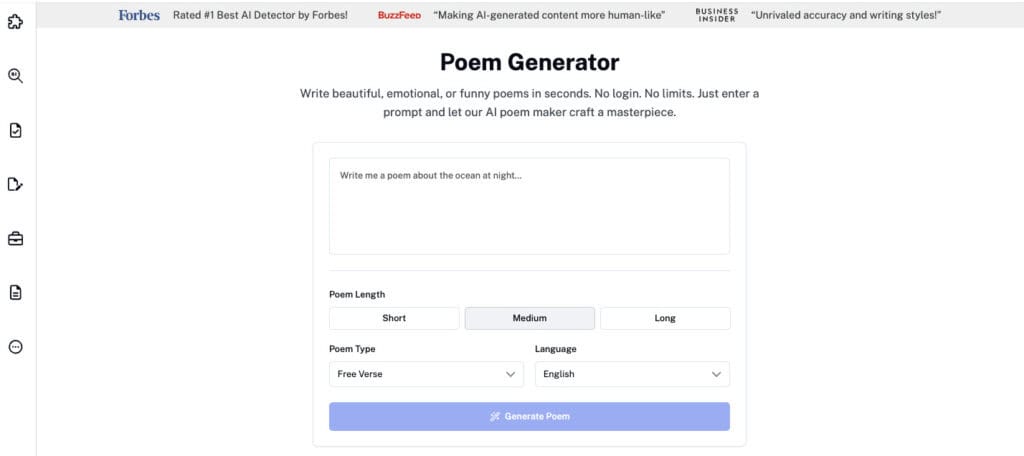
Ambiguity in Law
Legal language is meant to be precise. But in reality, it’s one of the biggest places where ambiguity causes confusion.
- For example, take the rule: “No vehicles in the park.”
This sounds straightforward, but when you start to think about it, you might wonder what technically counts as a vehicle.
Does the rule include bicycles? Motorcycles? What about mobility scooters? Or a child’s electric toy car?
This type of legal ambiguity can lead to a whole host of legal problems.
And it’s why lawyers, lawmakers, and judges spend so much time debating language itself, because a single misplaced word, comma, or phrase can completely change how a law or contract is interpreted.
Ambiguity in Politics
If there’s one field where ambiguity thrives, it’s politics.
Politicians often use ambiguous terms to appeal to a broad audience.
- For example, a politician might say: “We believe in protecting family values.”
But what exactly does “family values” mean? This could refer to religion, traditional gender roles, or simply having compassion for people.
The phrase is open-ended on purpose because it allows the politician to avoid alienating certain groups.
Ambiguity in political language helps politicians:
- Gain wider support by letting different audiences project their own meanings onto statements and arguments.
- Avoid accountability by keeping their stance(s) flexible.
- Control narratives without having to commit to any hardline positions.
This kind of language can be very persuasive, but it’s also misleading.
Ambiguity in Media and Journalism
Ambiguity in media and journalism is a bit of a double-edged sword.
On the one hand, it makes headlines catchy and engaging.
But on the other hand, it can cause confusion when readers interpret stories based on a headline alone and not the intended meaning of the article.
- For example, an ambiguous headline could be: “Miners Refuse to Work After Death.”
Ambiguous headlines like this grab attention because they sound dramatic (which is great for clicks!), but they also leave readers unsure of what actually happened.
Did the miners die? Are they ghosts? Or are they protesting someone else’s death?
This kind of confusion might boost clicks, but it sacrifices clarity and can even spread misinformation.
Why Ambiguity Happens

Ambiguity isn’t always a sign of low-quality or manipulative writing.
It’s just a natural part of human language that happens because…
- Words carry multiple meanings and
- Context is subjective
The impact of this ambiguity can be both positive and negative. Here’s how.
Positive Effects
When used intentionally in arts and literature, ambiguity:
- Encourages interpretation and critical thinking.
- Adds depth and nuance that can’t always be captured with a direct statement.
- Creates mystery or suspense, making readers and viewers more engaged.
Negative Effects
There’s also a darker side to ambiguity, especially in business, politics, and media.
For example, ambiguity can lead to…
- Miscommunication when messages are interpreted in different ways.
- Costly mistakes when ambiguous contracts or instructions lead to legal disputes or financial loss.
- Wasted time when readers spend longer trying to interpret the meaning behind a piece of writing rather than focusing on the writing itself.
How to Avoid Ambiguity in Writing
So, how can you avoid unintentional ambiguity in your own writing?
Here are some quick, practical tips:
- Use clear, natural language. Write the way people naturally speak, and try to avoid sounding overly formal or robotic.
- Be specific with word choice. Choose words that express your exact meaning. Avoid terms with multiple interpretations, unless you’re deliberately creating ambiguity for a creative writing project.
- Simplify your sentence structure. Aim to keep your sentences clean and direct. Overly complex structures often lead to syntactic ambiguity, which leaves readers feeling unsure of how different parts of a sentence connect. When in doubt, break up a long sentence into two or more short sentences.
- Clarify pronoun references. Make sure any pronouns (like he, she, they, or it) clearly refer to a specific noun. If you’re not sure if it’s clear or not, simply repeat the noun for added clarity.
- Read your writing out loud. Hearing your words out loud can help you catch unnatural phrasing or words with two meanings you might miss when reading silently.
Pro Tip for Writers and Students: To make sure your writing is free from ambiguous sentences, use a tool like Undetectable AI’s Grammar Checker to find and correct structural ambiguity in your writing. And if you’re stuck on a clunky passage, use AI Paraphraser to transform confusing sentences into smooth, natural language without sacrificing tone.
Use the AI Checker to review AI-generated writing for unclear or overly complex phrasing.
It quickly identifies whether your content sounds natural or contains patterns that may create confusion or ambiguity, helping you refine sentences for maximum clarity.
Ambiguity vs. Vagueness: What’s the Difference?
While ambiguity and vagueness are closely related, they’re not technically the same thing in formal writing and linguistics.
Both terms cause confusion, but they cause that confusion in different ways.
The following table outlines the key differences between ambiguity and vagueness.
| Ambiguity vs Vagueness: Key Differences | ||
| Ambiguity | Vagueness | |
| Definition | A sentence or phrase with more than one distinct meaning. | A sentence or phrase where the meaning is unclear or not precise. |
| Example | “The professor said on Monday he would give a test.” | “She’s doing well.” |
| Cause | Word choice, sentence structure, or syntax (i.e., how a sentence is arranged). | Missing context or specific information. |
| Effect | Can be misleading or confusing due to multiple interpretations. | Leaves people feeling uncertain about what the writer or speaker intended to say. |
| How to Fix | Clarify sentence structure or wording. | Add additional details or context. |
Enhance your work with our AI Detector and Humanizer—start below!
Frequently Asked Questions About Ambiguity
What is moral ambiguity?
Moral ambiguity refers to a situation, character, or decision that doesn’t clearly fall into the categories of “good” or “bad”.
Common examples of morally ambiguous characters that challenge traditional moral beliefs include Walter White (Breaking Bad), Severus Snape (Harry Potter), and Tony Soprano (The Sopranos).
What is fundamental ambiguity?
Fundamental ambiguity is when an idea or statement can be understood in more than one way, and there’s no single correct answer. For example, the question “What is the meaning of life?” is fundamentally ambiguous because everyone can see it differently.
Final Thoughts On Ambiguity in Writing
Ambiguity is one of those fascinating language quirks that can either elevate or completely derail your writing, depending on how and where you use it.
As a rule of thumb:
- Use ambiguity intentionally in creative writing projects (like poems, essays, and fictional stories).
- Try to avoid ambiguity in academic, professional, and business contexts.
And if you ever get stuck trying to figure out whether something sounds ambiguous or not, run your writing through Undetectable AI — use its Grammar Checker, AI Humanizer, and other tools to ensure your writing is clear, polished, and authentic.
